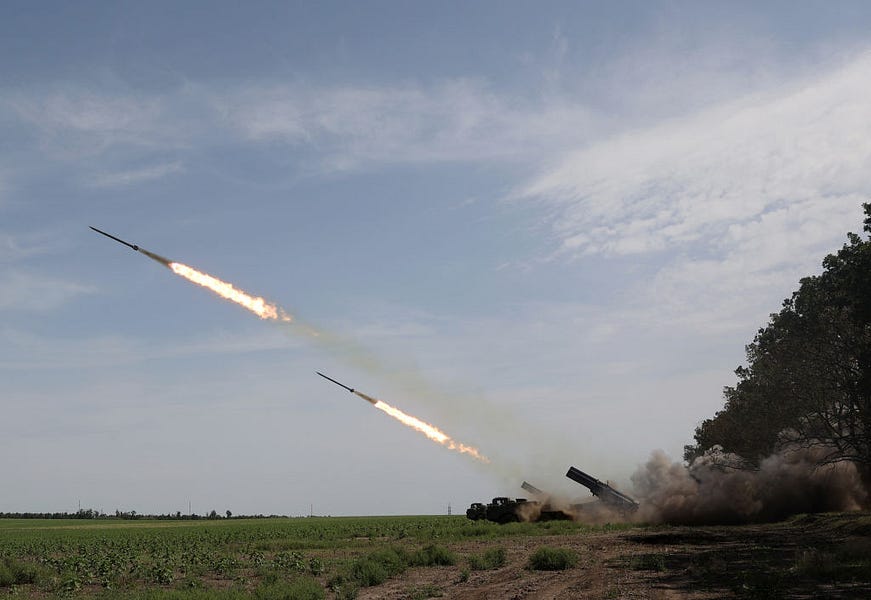It’s been some time since I wrote about the war in Ukraine. My most recent newsletter dedicated to covering the war was all the way back on May 31, and it tracked Russia’s change of strategy after its first offensive ended in failure. The Russian army was doing what the Russian army does—doubling down on raw firepower. It had abandoned its reckless, disastrous attack on Kyiv, focused its forces on the Donbas region, and was wearing down Ukrainian forces through ruthless, relentless bombardment.
Russia took Mariupol. It took the city of Severodonetsk. Multiple sources reported that Ukraine was taking casualties at rates that exceeded 100 deaths per day. In my newsletter, I sounded three alarms. First, I said that Russia was playing by its rules now. It had abandoned the failed tactics of the initial, attempted lightning assault and was resorting to type.
Second, I said that Russia could fight like this for a long time. It had immense stocks of artillery and ammunition and could pound Ukrainian positions for weeks on end.
Third, I argued that Ukraine did not have a clear path forward. While the western arms pouring into Ukraine were enough to slow the Russian advance to a crawl, they didn’t appear to be enough to meaningfully reverse Russian gains.
Now, three months later, the situation appears to have changed. The moment of peril has shifted from Ukraine to Russia. While the fog of war is thick, and we don’t have clear visibility on the size or strength of the Ukrainian attack, it appears that a long-awaited Ukrainian counter-offensive is underway. Here’s the New York Times:
Ukrainian forces launched ground assaults on Monday in multiple areas along the front in the Kherson region of southern Ukraine, apparently stepping up a counteroffensive aimed at recapturing territory seized by Russia.
And here’s the Institute for the Study of War:
Ukrainian military officials announced that Ukrainian forces began a counteroffensive operation in Kherson Oblast on August 29 after severely disrupting Russian ground lines of communication (GLOCs) for weeks. Southern Operational Command Spokesperson Nataliya Gumenyuk stated that Ukrainian forces “began counteroffensive actions in many directions” and have broken through the first line of defense in an unspecified area.
What to make of all of this? Ever since the war broke out, I’ve been vacuuming up information about the conflict, both by talking to sources within the government and by reading every scrap of civilian information I can find. And I find that it’s getting harder to figure out what’s really going on.
The initial phase of the war was relatively easy to track. Even on civilian satellite systems you could see the Russian convoys headed towards Kyiv. The Russian failure to take the capital city was obvious. The Russian retreat from Kyiv was splashed all over every major media outlet in the world. Reporters walked past lines of destroyed Russian tanks and through towns liberated after the Russian retreat.
When combat shifted to the Donbas, the fog of war got much more dense. Aside from the moments when cities fell, the gains were incremental. The rhythm of attack and counterattack meant that it was tough to tell whether any given Russian advance was meaningful. Only the overall narrative was clear—Russia was using its firepower to attempt to grind down the Ukrainian force.
Now a new narrative is emerging. It appears that the Ukrainian military has weathered the assault in the Donbas well enough. Ukrainian forces took severe losses, but Russia did not break through. Now Ukraine is striking back, and three things seem reasonably clear.
First, Russian forces in Kherson appear vulnerable. The city of Kherson sits west of the Dnipro River, and that means Russian defenders risk being cut off from resupply and reinforcement. After weeks of “shaping operations” (military operations designed to create favorable conditions for battle), Ukrainian forces have destroyed or damaged the bridges the Russians use to resupply their forces in the field.
As a result, Ukrainian forces have a clear opportunity to win their most significant battlefield victory since the rout of Russian forces in the north. Retaking Kherson wouldn’t be a war-winning stroke, but it would deal a significant defeat to the Russian army and could help rally the spirits of western European allies who are facing the prospect of a long, cold winter without their normal access to Russian gas.
Second, don’t expect a true Ukrainian breakthrough. I’m reasonably optimistic (though far from certain) about a Ukrainian victory in Kherson, but I don’t dare hope for much more than that. The simple fact is that the kind of mobile warfare that enables rapid advances has been mastered by only the smallest number of militaries. It requires well-trained, well-equipped, and well-supplied troops who are powerful enough to punch holes in the Russian line and mobile enough to rapidly exploit any tactical gain.
Yet the Ukrainian military has taken massive losses. Many of its best units have been used up in months of intense combat. While the Ukrainian people have rallied, and Ukraine can replace its losses, new troops are green. They’re barely trained. We can hope and pray that an army that possesses a hodge-podge of Soviet and western gear, is manned by a combination of worn-out vets and raw recruits, and confronts an enemy that still possesses an immense amount of firepower can somehow break clear through Russian lines, but that’s more a wish than a plan.
That’s not to denigrate any potential victory in Kherson. Retaking a significant city is a milestone achievement. But don’t expect too much.
Third, expect the war of attrition to continue. Last week, just before Ukraine launched its counterattack, Russian president Vladimir Putin announced plans to increase the size of his military by 137,000 troops. Russia is aiming for a total of 1.15 million active duty service members, out of a total planned force of 2,039,758 military personnel of all types.
It’s an open question whether that will be enough to accomplish Putin’s goals. Ukraine, after all, is aiming for its own million-man military. But there is no real sign that Russia is seeking an exit from the conflict. Indeed, even as Ukraine launches its own offensive in Kherson, Russian forces are still making small gains elsewhere.
One hesitates to compare the present war to the conflicts of the 20th century, but I am reminded of the Korean War after Chinese intervention and after the front stabilized roughly around the present-day demilitarized zone. The two forces could and did launch offensives, but neither side was able to achieve a true breakthrough.
If Russia doesn’t fully mobilize, and Ukraine continues to receive a steady stream of western support, one wonders if Russia will possess the raw strength to break the Ukrainian military. At the same time, if Ukraine isn’t supplied with the kinds of offensive weapons (such as western tanks and western fighter jets) that can truly transform the battlefield, one wonders if a military that is taking its own staggering losses can push Russia off its territory.
Last night Tucker Carlson took a look at the reality on the ground and came up with his own bold proclamation. “By any actual reality-based measure,” he said, “Vladimir Putin is not losing the war in Ukraine. He is winning the war in Ukraine.”
This is deranged. Putin’s fundamental war aims have been frustrated, and his military has taken losses that will take years to replace. Indeed, as the Institute for the Study of War has mapped, Russia has lost territory the size of Denmark since the highwater mark of its first advances:
Both of Putin’s major offensives—the first broad thrust to decapitate the regime and the second, more limited attack in the Donbas—have been either stopped or slowed to a crawl. If all of this is what winning looks like for Putin, I’m reminded of Pyrrhus’s quote after he defeated the Romans at Asculum in 279 B.C.: “Another such victory over the Romans, and we are undone.”
Putin may end up controlling additional Ukrainian territory, but as of now, just as there is no clear path for a complete Ukrainian victory, there is no clear path to Russian domination. Much of the Russian military’s years-long modernization effort is now a shattered ruin across the Ukrainian countryside. And now, today, he faces the prospect of another consequential military defeat.
Three months ago I was sobered and pessimistic about Ukraine’s short-term prospects under withering Russian bombardment. I’m still sobered, but I’m now more optimistic about the chances of meaningful Ukrainian success. The tide of war seems to be turning again, and this time Russia’s fortunes are on the wane.









Please note that we at The Dispatch hold ourselves, our work, and our commenters to a higher standard than other places on the internet. We welcome comments that foster genuine debate or discussion—including comments critical of us or our work—but responses that include ad hominem attacks on fellow Dispatch members or are intended to stoke fear and anger may be moderated.